

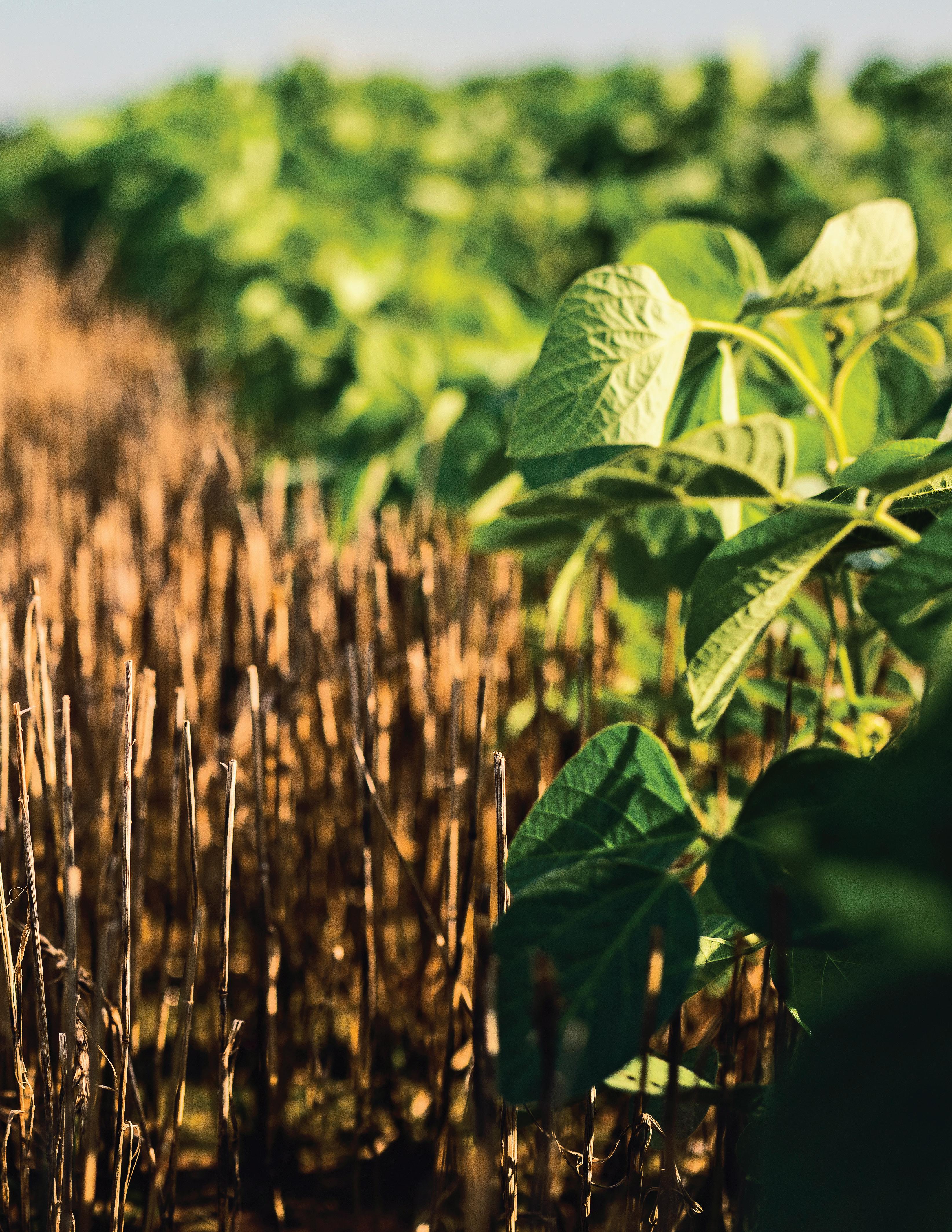









From promoting the profitability of using high-quality soybean meal in India to training animal producers on nutrition in Colombia, the soy checkoff is working behind the scenes to develop more market opportunities for U.S. soy. We’re looking inside the bean, beyond the bushel and around the world to keep preference for U.S. soy strong. And it’s helping make a valuable impact for soybean farmers like you.


See more ways the soy checkoff is maximizing profit opportunities for soybean farmers at unitedsoybean.org










WhenRyan Rhoades
Ohio Soybean Association President Marion County soybean farmer
the world thinks back on 2020, it will likely be a year many wish they could forget. But in the world of soybeans, some good things have happened in 2020. In January, the Trump administration signed the Phase 1 trade deal with China. As I am writing this in October, prices are higher than they have been since early 2018, and from what I have seen and heard, the 2020 crop is expected to be good in Ohio. Like every year, farmers have been committed to growing a quality product despite the hardships thrown our way.
One thing that has not wavered this year is the Ohio Grain Farmers Symposium, an event we host every year in partnership with the Ohio Corn & Wheat Growers Association. Mark your calendars to attend virtually on December 7. This event is free for all to attend, but please RSVP at www.ohiograinfarmerssymposium.org to reserve your spot. We will feature discussions on trade, weather and what the outcome of the election could mean for agriculture in the next four years.
As I mentioned, I am writing this letter in October, but Christmas ads have already started to roll on TV. If you are looking for a gift for that hard-to-buy-for person, consider giving the gift of membership this year. Our memberships start at just $80 and are a great way to show your favorite soybean farmer or industry leader how much you care about them and the future of soybeans in Ohio. The more members we have, the better we can represent Ohio soybean farmers’ interests in Columbus and Washington, D.C.
I also recommend encouraging the college students in your life to apply for the Ohio Soybean Council Foundation Scholarships. These annual awards are given out to students who will make a difference in the future of the soybean industry. Past winners have gone on to work as agronomists, food technologists and agricultural and chemical engineers — careers that are all vital to the longevity of the our industry. Students interested in applying should visit www.soyohio.org/scholarships to view more details and begin their application.
I hope you all had a plentiful and safe harvest. Wishing you a peaceful and happy holiday season!

Ryan Rhoades OSA President Marion County
President
Ryan Rhoades, Marion County
First Vice President
Patrick Knou , Shelby County
Vice President
Jennifer Wilson-Oechsle, Van Wert County
Treasurer
Je McKanna, Hancock County
Secretary
Rusty Goebel, Williams County
Chairman
Scott Metzger, Ross County
Trustees
Jerry Bambauer, Auglaize County
Trish Cunningham, Knox County
Bret Davis, Delaware County
Caitlyn Heimerl, Industry A liate Ex-O cio
Justin Esselburn, Wayne County
Je Magyar, Ashtabula County
Derek Reusser, Holmes County
Andy Stickel, Wood County
Kerrick Wilson, Preble County
American Soybean Association
Board Representatives
Jerry Bambauer
Bret Davis
Scott Metzger
Staff Credits
Kirk Merritt - Publisher
Jennifer Coleman - Editor
Julia Brown - Contributing Editor/Sta Writer
Brent Warren - Art Director
Barry Falkner - Photo Quality/Proofer
Jennifer Richburg - Advertising Production
Ohio Soybean news is published six times a year by the Ohio Soybean Association, 918 Proprietors Rd., Suite A, Worthington, OH 43085. Phone: 614-476-3100. For address corrections contact Ohio Soybean News at 918 Proprietors Rd., Suite A, Worthington, OH 43085.
Web address: www.soyohio.org E-mail: cdeboard@soyohio.org
Comments and statewide news articles should be sent to the above address. Advertising space reservation must be made by the rst of the month preceding publication. In consideration of the acceptance of advertisement, the agency and the advertiser must, in respect of the contents of the advertisement, indemnify and save the publisher harmless against any expense arising from claims or actions against the publisher because of the publication of the content of the advertisement.
For Advertising Sales Contact:
Matt Herman - (612) 812-5833
matt.herman@dtn.com


The Ohio Soybean Association would like to thank its 2020 Corporate Sponsors
Cultivator Level


Contributor Level



Supporter Level






Friends of OSA



If you are interested in supporting the Ohio Soybean Association as a Corporate Sponsor in 2021, please contact Emilie Regula Hancock at eregula.hancock@soyohio.org




At the beginning of October, Senate Commerce Committee Chairman Wicker (R-MS), Schatz (D-HI) and Rubio (R-FL) introduced the Advancing the Quality and Understanding of American Aquaculture Act (AQUAA Act).
The bill creates a balanced framework for the development of offshore aquaculture in the United States, focusing on the unique issues arising from offshore aquaculture and creating a joint permit application that consolidates all federal agency requirements so that applicants can fill out a single online form. A similar bill, HR 6191, was previously introduced in the House.
The bill would set up a research and development program that includes sustainable feeds (like soy) as a priority. The bill requires the research and development grant program to award competitive, peer-reviewed grants to fund research and extension services to create innovative designs and engineering solutions to industry problems, develop new technologies, develop cost-effective and sustainable feeds, improve monitoring techniques, and evaluate impacts of offshore
aquaculture on economies of coastal communities.
USDA Invests Up To $100 Million to Increase American Biofuel Sales. In early October, U.S. Secretary of Agriculture Sonny Perdue announced that the U.S. Department of Agriculture (USDA) has invested $22 million out of the up to $100 million in grants available to increase American ethanol and biodiesel sales. These funds were made available through the Higher Blends Infrastructure Incentive Program (HBIIP) to recipients in 14 states. The initial $22 million in HBIIP investments are projected to increase ethanol demand by nearly 150 million gallons annually.
“Investments made through the Higher Blends Infrastructure Incentive Program are helping rural communities build stronger economies and will give consumers more choices when they fill up at the pump,” Secretary Perdue said. “President Trump has expanded
Page and Wade Thorson of Benchmark Biodiesel received a grant from USDA to build new biodiesel dispensers.
ethanol use by unleashing yearround E15, and the result is more demand for American farmers and more affordable fuel for American consumers.”
USDA is funding projects in California, Florida, Iowa, Illinois, Indiana, Kansas, Kentucky, Minnesota, Missouri, Nebraska, New York, Ohio, Utah and Wisconsin. Money in Ohio went to Columbusbased Benchmark Biodiesel to replace two dispensers at a fueling station.
The Higher Blends Infrastructure Incentive Program helps transportation fueling and biodiesel distribution facilities convert to higher ethanol and biodiesel blends by sharing the costs related to the installation of fuel pumps, related equipment and infrastructure.
Eligible applicants are vehicle fueling facilities, including, but not limited to, local fueling stations/ locations, convenience stores, hypermarket fueling stations, fleet facilities, fuel terminal operations, midstream partners and/or distribution facilities. Higher biofuel blends are fuels containing ethanol greater than 10 percent by volume and/or fuels containing biodiesel blends greater than five percent by volume. u
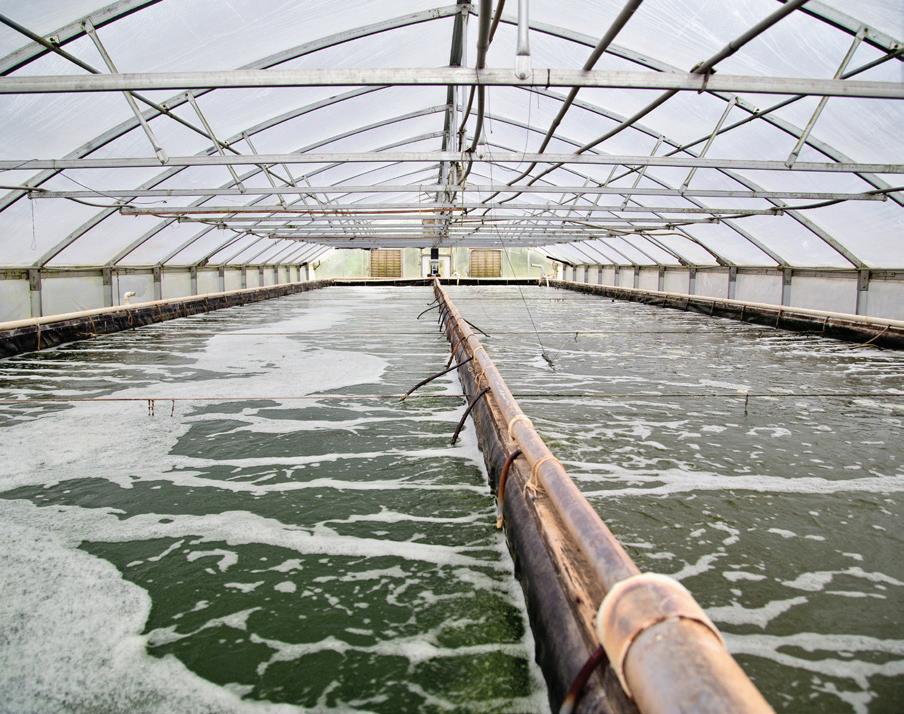
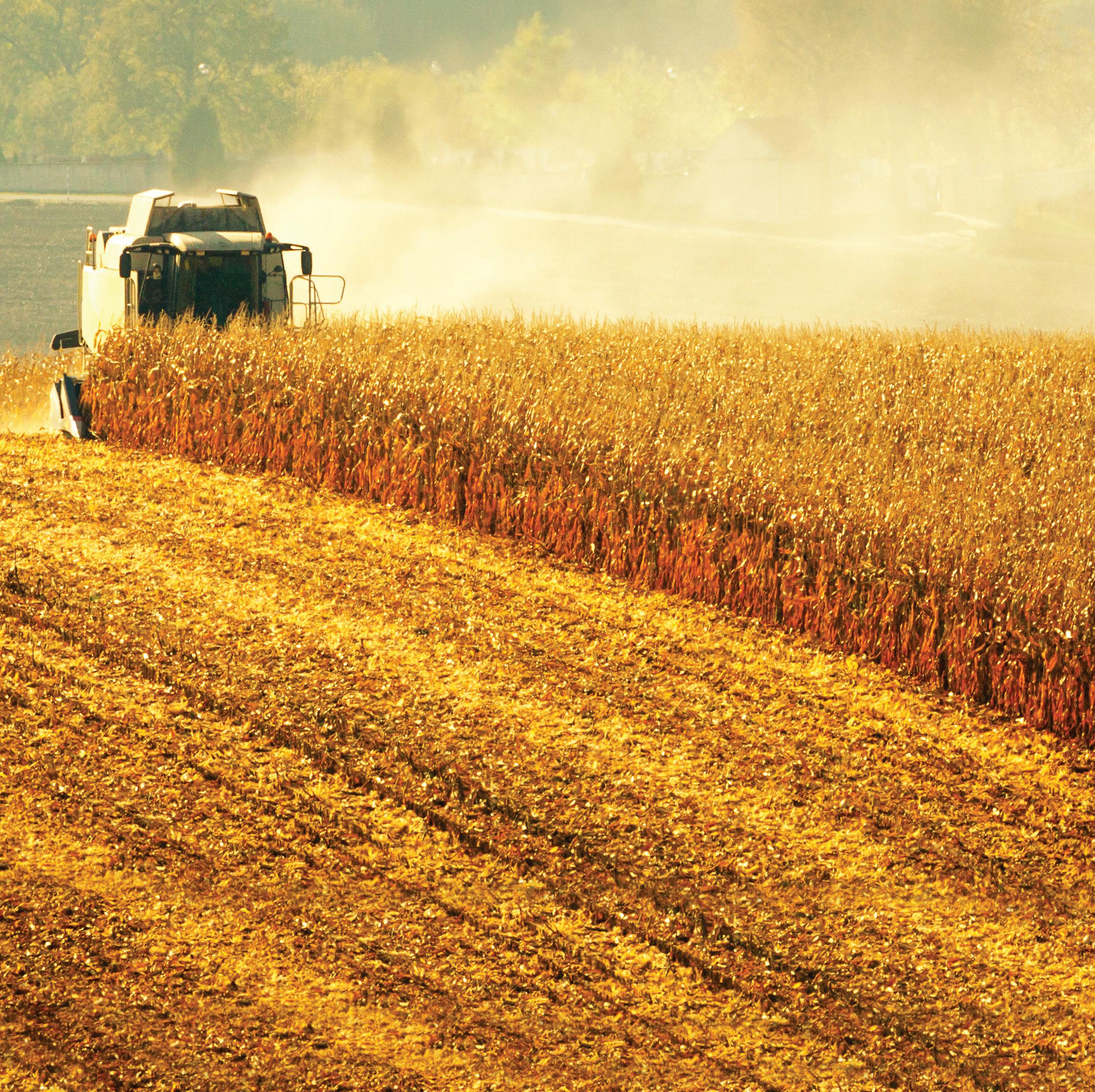



Eastern soils are unique and so are eastern farmers. We o er leading traits in genetics bred, tested and proven to perform on your farm. You’ll also receive assistance from seed professionals and agronomists, along with straightforward service and upfront o ers. It all adds up to Simply Better Solutions. See our website or call to learn more.
































































































Today’s farmers face many challenges. How can Ohio’s soy farmers keep their farms productive – and profitable – for the next generation?
Cargill is supporting farmers in their efforts to build healthy soil, boost resilience to climate change and future-proof their livelihoods. We can help tap into knowledge, tools and technology to improve soil –and yields.
Our growing partnership with The Ohio State University’s College of Food, Agricultural, and Environmental Sciences enables farmers to access cutting-edge expertise as they adopt and scale healthy soil practices.
Together, we help farms make a positive impact on local water quality, complementing the H2Ohio Initiative. The assistance includes offering farmers innovative monitoring tools and technology, such as utilizing drones to check soil and crop conditions. The university conducts on-farm research to measure effectiveness, benefits and return on investment.
Cargill is continuously expanding projects to improve soil health, boost yield stability, reduce nutrient loss and bump up carbon sequestration.
Reach out to your Cargill representative to learn more about current or future programs in your area.
Agriculture is how we will regenerate our soil.






















HERE’S HOW THE SOY CHECKOFF WORKS. The national soy checkoff was created as part of the 1990 Farm Bill. The Act & Order that created the soy checkoff requires that all soybean farmers pay into the soy checkoff at the first point of purchase. These funds are then used for promotion, research and education at both the state and national level.

Half goes to the state checkoff for investment in areas that are a priority for that state.


1/2 of 1% of the total selling price collected per the national soybean act & order


Half goes to the national checkoff for investment in USB’s long-range strategic plan.



By Scott Gerlt, American Soybean Association Economist
On Sept. 17, the Administration announced the second round of the Coronavirus Food Assistance Program (CFAP2) to help the agricultural sector sustain the losses from the pandemic. Without government payments in 2020, net cash income is expected to drop by about $10 billion. Severe disruptions, including reduced disposable incomes, supply chain bottlenecks and changed food consumption patterns, have negatively affected prices in the agricultural sector. This impact, on top of several years of a trade war and the significant drop in international soybean demand through Africa Swine Fever’s devastation of China’s swine herd, necessitated the additional program.
Commodities eligible for CFAP2 fell into one of three categories: major commodities that experienced at least a 5% price reduction, flat-rate crops and specialty crops. Flat-rate crops receive $15 per acre. Since soybeans experienced a 7% price decline between mid-January and late July, it fell into the major commodities that experienced at least a 5% decline, and soybean producers receive the higher of $15 per acre or $0.3132 multiplied by their crop insurance APH yield per acre. If an APH yield is not available, 85% of the weighted 2019 Agriculture Risk Coverage-County Option benchmark yield is used. The $.3132 per bushel rate is achieved by multiplying the price drop of $0.58 per bushel by the nationwide marketing percentage for soybeans of 54%. For more examples of the calculations and more details, visit https://bit.ly/3lLE6yW
Although individual data is not publicly available for CFAP2 analysis,
what is available can still reliably be used to analyze the effects of CFAP2 components and the geographic distribution of payments. The USDA Risk Management Agency reports county level data about crop insurance purchases. This information can be used to calculate the average soybean APH yield by county. About 75.1 million acres were insured to soybeans in 2020 compared to 83.8 million that were planted. Since there were very few prevented plant acres this year that would exclude producers from CFAP2, the crop insurance data captures the bulk of what will be used to calculate the payments. Figure 1 shows the geographic distribution of the payments by county using this data. Many of the counties receive the minimum of $15 per acre, although Kansas, Nebraska, Iowa, Minnesota, Illinois, Indiana and Ohio have multiple counties exceeding it. The higher end of the per-acre payment distribution is in the lower $20 per acre range. Keep in mind that the figures using the average APH yields will likely be lower than the county average payment using individual yields. To demonstrate, an APH yield of 47.9 bushels per acre would generate a payment of exactly $15 per acre before the cap is applied. If the county average APH were 47.9, very likely some producers would have APH yields below this but would still receive



the $15 per acre. Producers above the average would receive more than $15 per acre, so the average county payment would exceed the rate with the county average APH yield.
Planted acres reported to the Farm Service Agency of USDA will be used to determine the CFAP2 payment per farm and total 80.8 million acres to date for soybeans. If the county totals
from this dataset are multiplied by the estimated county rates, total payments are $1.330 billion. USDA estimated that soybean CFAP2 payments would total $1.386 billion. The reasons for the discrepancy are twofold. First, USDA was likely using individual APH yields which are not available to the public. This would make total payments higher. Second, they also calculated the effect of payment and Adjusted Gross Income limits which would bring that total back down.
Figure 2 shows how the two components of the payment affect the total. The graph orders the estimated county rates and plots them against the planted acres in the county. However, the planted acres are cumulative meaning they are added to the planted acres for all of the other counties that have a lower payment rate. The raw payment rate before the $15 cap is shown in green, and the effect of imposing the $15 minimum is shown in orange. As can be seen in the chart, about 35 million soybean acres will benefit from the $15 per acre payment cap. The area of each series in the graph corresponds to the total effect of the component. Even though 43% of the acres benefit from the cap, removing it would only reduce total payments by $86 million (6%). Keep in mind that this is a lower bound due to the previously mentioned averaging issue. On the other hand, the price-based component determines $1.244 billion of the CFAP2 soybean payment (94%). If soybeans had not experienced at least a 5% price decline, they would have been a flat-rate commodity and received $15 per acre. In this case, the payments would have totaled $1.211 billion.
Given the nature of the CFAP2 payment formula, total soybean payments will be highly correlated to the production of soybeans (Figure 3). Illinois and Iowa will likely receive the most payments followed by Minnesota and Indiana. Note these estimates are for soybeans only, so the total CFAP2 payment distribution will vary from this. Based on the available data, at
least 33 states will receive payments for soybeans. Some of these states display a “0” in Figure 3 due to rounding.
In summary, CFAP2 is helping to provide much needed support to soybean producers. The $15 per acre floor will be beneficial to many. Even so,
its contribution to the total payments for soybeans is quite small. States that will receive the most benefits will be those that produce the most soybeans. However, soybean producers in at least 33 states will likely receive assistance through the program. u


ADVOCATING FOR YOUR BUSINESS
Ohio Farm Bureau advocates for agriculture with legislators, regulators, in the courts and with the media. Farm Bureau’s position on issues works through a grassroots process that starts with the county Farm Bureau, then state and ends with the American Farm Bureau in Washington D.C.

SHAPING YOUR FUTURE WORKFORCE
Ohio Farm Bureau Foundation created ExploreAg to start recruiting a workforce the future agriculture industry needs by encouraging young people to consider a career in the food, farm and fiber industry.

MONEY SAVING BUSINESS SOLUTIONS
Members save by accessing our Health Benefits Plan, Workers’ Comp group rating program, energy program, and Nationwide® Insurance products and services, plus much more. Members save on brands like Ford, John Deere, Case and CAT to name a few.




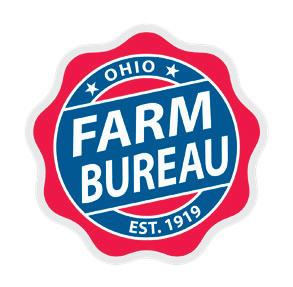




When it comes to conservation practices, one of the biggest barriers to access for farmers is cost. They must carefully consider how the practice will impact their bottom line and decide if it is worth the financial risk to implement it. Fortunately, cost sharing programs exist to alleviate these concerns. Another opportunity for cost sharing recently started in Ohio.
The Walton Family Foundation provided $30,000 to help Ohio farmers who have never used cover crops before –or had not used them in a while – try the practice for free. Seed was provided by Beck’s at a reduced cost and aerial seeding was provided by Fisher’s Crop Care by Air. In its first year, the lowrisk, low-management program, which was facilitated by a partnership between the Ohio Soybean Council (OSC) and the Ohio Federation of Soil and Water Conservation Districts (OFSWCD), has nine total participants in Ashland and
Aerial application of cover crops allows seeding to be done when crops are present or when the soil is too wet for regular equipment.
Sandusky Counties. This year, costs went toward covering close to 300 acres in a variety of crops, including an oat/radish mix, barley and rye.
The program has several benefits. Most immediately, it will help improve soil health and water quality, which is the primary goal of the Walton Family Foundation’s investment. At the same time, international and domestic customers alike want to know that Ohio soybeans are being grown using sustainable production practices.
Cover crops may also provide a direct economic benefit to farmers. According to the Sustainable Agriculture Research and Education Cover Crop Economics Report from 2019, farmers may see an average savings of $2 per acre for reduced expenses in erosion repair and beginning in year three, up to $10 per acre savings in weed control costs. Cover crops can also help farmers reduce fertilizer and herbicide application, saving them up to $8.40 an acre and $27 an acre, respectively.
Dr. Scott Shearer
Nikki Hawk, who serves as the Ohio Agriculture Conservation Initiative project leader for OFSWCD, helped coordinate the effort. “We were excited to partner with the Ohio Soybean Council and the Walton Family foundation on this
effort to get conservation on the ground and introduce cover crops to producers who have not done them in the past.”
She shared that oftentimes when margins are tight, it can be harder for farmers to justify spending the money to implement cover crops. “We thought this program might appeal to people who wanted to try it because it was essentially zero risk, zero investment for the producer for the first three years,” Hawk said.
Erica White, district technician for the Ashland Soil and Water Conservation District, worked on the program as well. “This was a great opportunity for our Ashland County producers because we don’t have a lot of cost sharing,” she said. White also mentioned that cover crops can be a good way to connect with the public on conservation issues, in addition to the environmental benefits. She explained that, so far, she has heard positive feedback from the participating farmers.
The program is set to run for three years, and Hawk hopes that in the future the program will include even more farmers. Farmers who are interested can contact her directly at nicole@ofswcd.org. u
Cover crop seed being loaded into a plane to be applied in Ashland County.



The Ohio Soybean Council (OSC) received its 12th R&D 100 Award at the 58th annual R&D 100 Awards. The award was given for the Handheld Sensor for Screening Crop Quality that was funded with Ohio soybean farmers’ checkoff dollars. The R&D 100 Awards honor the 100 most innovative technologies of the past year. OSC won in cooperation with The Ohio State University in the Software/Services category and has received seven R&D 100 Awards in the last seven years.
The agriculture industry has a demonstrated need for a userfriendly technology that provides crop composition analysis — i.e., quality evaluation — in situ and at a reasonable price. A crop’s quality is most fully and accurately determined through chemical characterization in terms of essential amino acids, protein, starch, sugar, oils, moisture, and other components (the exact mix required varies from crop to crop). The traditional testing methodology — sending samples to a lab — has been the “gold standard” in crop analysis, but it is costly and time-consuming.
This mobile device allows individual farmers to analyze their own products and evaluate their quality — in the field, in seconds, and inexpensively. The technology uses near-infrared (NIR) spectroscopy to provide a profile of constituents. From the user’s perspective, the process is simple. The farmer collects the sample and places it in the sample holder. The NIR spectrometer collects data from the sample. The sensor processes the data and applies algorithms to quantify the components. Results are presented in an easy-to-read graphic or table format.
The sensor has tested a wide range of sample types—barley, corn, hemp, oats, potatoes, soybeans, meat, fish,
pea protein, and milk protein — and provides unprecedented accuracy for each measured component.
“We are incredibly proud that the technology being developed with our Ohio soybean checkoff dollars is being recognized alongside work from institutions like MIT and the U.S. Department of Homeland Security,” said Todd Hesterman, OSC Research Committee chair and soybean farmer from Henry County. “Not only is this

device one of the most technologically significant products from the last year, it also has a direct benefit to farmers in the field.”
The entire system, at roughly 3" x 6", is readily portable. It is easy to use and can be operated with an app on a smartphone or tablet. The device is also cost-efficient; farmers can make a reasonable one-time purchase (as opposed to paying costly and recurrent lab fees), and the sensor consumes very little power.
“We are both proud and honored that the R&D 100 Award Committee has recognized this technology and its advantages,” said Barry McGraw, OSC’s Director of Product Development & Commercialization. “This invention meets a long-standing need. It allows
farmers to evaluate their own products’ quality — and do it on the spot. Now farmers can make informed and timely decisions to improve the quality of the harvest.
“And the benefits go beyond the farm,” McGraw added. “The sensor can be used at the point of sale so buyers know exactly what is on offer. Thanks to this tool, we could move toward a market system that rewards farmers who cultivate better produce.” u
For more information about this handheld sensor, OSC’s role in its development, or licensing, please contact Barry McGraw at bmcgraw@soyohio.org











Soybeans are no stranger to the energy industry — they are already used in biodiesel to fuel vehicles and Bioheat® to heat homes. Now soybeans are making the jump to the oil and gas industry.
Manoj Valluri, a reservoir engineer at Battelle who helped develop the surfactant, explained that there are a lot of legacy oil and gas wells, especially in the middle of the country. Surfactants are essential to revitalizing oil and gas recovery from these wells. They reduce the surface tension between oil and water in rock formations while stripping oil from the rock surface, making oil easier to extract. The global surfactant market is set to grow at about 4.6 percent through 2023, when it will reach $1.09 billion. However, most of these products use reagents that are toxic and costly to source. Battelle, in partnership with the Ohio Soybean Council (OSC) and soybean checkoff, has developed and is currently testing a soy-based alternative.
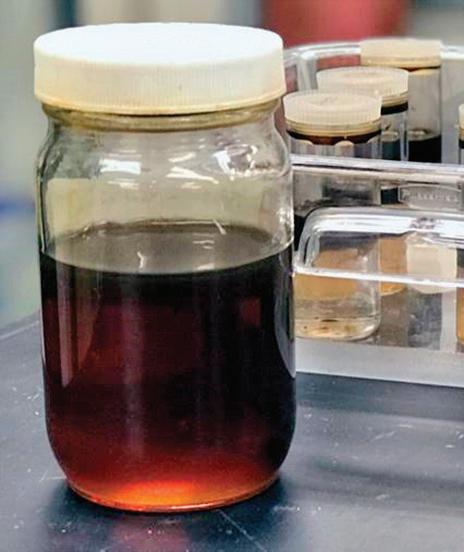

Soy-based cationic surfactant being tested for improved oil recovery applications for existing oil and gas wells.
The soy-based surfactant offers several benefits over traditional synthetic surfactants. Raw materials for synthetic surfactants are often sourced from overseas, sometimes from limited or unstable markets, which leaves supply chains vulnerable to disruption or price instability. This new surfactant uses soybased raw materials that can be readily and locally sourced, offering a secure, reliable and economical supply chain.
Synthetic surfactants present environmental and health concerns.
The OSC-funded soybased alternative is derived from non-toxic, generally recognized as safe (GRAS) epoxidized soybean oil or epoxidized soybean oil methyl ester. “Factoring in a biodegradable and plantbased component like soy will help the industry keep environmental concerns in check,” Valluri said.
Testing has shown that the soybased surfactant outperforms selected commercially available surfactants. It has demonstrated good thermal stability, promoted water wetness in reservoir rocks, and recovered more oil
Injecting the surfactant into a test well located in Morrow County, Ohio.
than the commercial agents tested. Valluri explained that the chemical could have applications in other markets as well, including as an anticorrosion agent, meaning that the checkoff’s investment in this product could lead to other new products beyond its original scope.
“The Ohio Soybean Council and soybean checkoff always has a goal of diversifying our portfolio of new uses,” said Todd Hesterman, OSC research committee chair and Henry County soybean farmer. “Positioning soybased products to be used by the oil and gas industry will build a new market for Ohio soybeans, and make our farmers more profitable.”
The soy-based surfactant has gone through its first round of testings with wells in the field with promising results, according to Valluri. Currently, it is being put through another series of tests, and Valluri conservatively estimated that the product will be available commercially within the next three years.
This could be the beginning of more collaboration with the oil and gas industry — surfactants are just one subset of chemicals used in the oil and gas industry and soy-based products could be developed to replace others.
“If this project can eventually lead to a bridge between farmers and the oil and gas industry,” Valluri said, “then the opportunities are endless.” u


With so many new agricultural technologies coming on the market, how do you evaluate which products to invest in for your farm?
Chris Gaesser grows corn, soybeans, and rye seed near Lenox, Iowa.
He first began using yield monitors in 1996. Since then he has invested in many technologies including autosteer, swap control, row shut-offs, mapping technology, and variable rate application. He also began utilizing data analysis, and applications for tracking hauling.
Gaesser first evaluates new technology based on what he’s using it for.
“Sometimes, it’s a matter of does it make our life easier, is it more convenient, and can we get something done faster? That’s worth something,” Gaesser said. “Other times it’s: is it actually making us money and is there a return on the investment we’re making?”
For example, autosteer doesn't make him more money, but it allows for less mental fatigue. Autosteer allows Gaesser to run longer hours and get things done in a more timely manner. However, a product like variable rate or swath control can actually save input costs, and he can put a number to that.
“There’s a lot of cost-benefit analysis, especially with the things that are more convenient or create less stress. Is the benefit you gain worth how much you’re paying?” Gaesser said.
Gaesser feels it’s important to evaluate new technology for more than one year, especially if it’s an item that you have to run in a field.
“You might get good results from a year, but the weather and other factors change from year to year,” Gaesser said. He likes to test out new technology for three years before completely investing in it.
“We tested variable rate nitrogen on a chunk of our acres for four or five years before we were convinced that it was doing what we wanted it to do,” Gaesser said.
So what are the keys to putting a number to a precision technology investment?
“We keep really good records on what we spend. For things that are saving us on inputs or increasing yields, that’s easy to tell,” Gaesser said. “We can just run the numbers and tell definitively if we’re making money from it.”
However, it’s not that easy for all products.
“For convenience products, it becomes how you value time and stress level. Is what you’re paying enough of a reduction of stress or helps you get things done faster to make it worth it?”

For Gaesser, the chaotic weather patterns in recent years that have resulted in shorter windows to get in the field, have him put a higher value on products that will allow him to get things done faster.
“There will be years that if we can break even on the technology, we’re doing good to have it in years that it does better. In general, as long as you’re making money four out of five years, you’re doing ok,” Gaesser said.
Gaesser encourages others that are looking to invest in new technology to start small.
“Start on a small number of acres. A trap we fall into is where we think it works and we do it on all the acres,” Gaesser said. “Then, if you have a problem or it doesn’t work like you thought, you’ve messed up a lot of acres instead of just a few.”
He also advises to get help and ensure you understand the product.
“Don’t just guess at things or think you’ll just figure it out as you go. If you have
help and understand from the beginning, you’ll do much better,” Gaesser said.
Sometimes it can be better not to jump on to new technology right away. While Gaesser doesn’t want to discourage farmers, the reality is, sometimes it’s better to wait until the technology is proven.
“While I feel it’s good to try things and be on the cutting edge, there are always bugs that have to be worked out with new technology,” Gaesser said. “Especially if it affects a big part of your operation, tech problems can really shut you down. I’ve been bitten by that before.” u
This article originally appeared on PrecisionAgReviews.com. Precision Ag Reviews is the Ohio soybean checkoff-funded website where farmers can review precision ag technology and equipment to help other farmers make buying decisions.







Farmers in Iowa, Illinois, and Ohio will soon benefit from a new partnership between the Soil and Water Outcomes Fund and the U.S. Department of Agriculture’s Natural Resources Conservation Service (USDA-NRCS).
The Ag Technology and Environmental Stewardship Foundation (AgTech), a subsidiary of the Iowa Soybean Association, and other partners are recipients of a $7.3 million Regional Conservation Partnership Program Alternative Funding Arrangement (RCPP-AFA) award courtesy of the USDA-NRCS. The award is one of ten projects funded nationwide.
Created and jointly managed by the Iowa Soybean Association (ISA) and Washington, D.C., based Quantified Ventures, the Soil and Water Outcomes Fund uses investment capital to compensate farmers for positive environmental outcomes generated by conservation-oriented practices on their farms, specifically water quality improvement and enhanced carbon sequestration. These outcomes are independently measured and verified and then purchased by government entities and private corporations.
“In the past, we’ve focused primarily on the water quality benefits of conservation practices, but with the recent rise in interest surrounding carbon sequestration, this project allows us to focus on both water quality and carbon reduction efforts at the same time,” said Tom Fontana, the Ohio Soybean Council’s director of research and education.
A defining feature of the two-year award is to position USDA-NRCS as a purchaser of verified water quality

improvement outcomes generated by the Soil and Water Outcomes Fund.
The fund is currently working with farmers in Iowa. The new funding will allow for additional impact in Iowa and expansion into Illinois and Ohio.
Over the next two years, participating farmers will be compensated for nitrogen and phosphorus reduction and carbon sequestration outcomes from practices such as cover crops and no-till used on an estimated 180,000 acres. The resulting environmental outcomes are estimated to be 3.24 million pounds of nitrogen reduction in water, 270,000 pounds of phosphorus reduction in water, and 135,000 tons of CO2e sequestered in soil.
Work is expected to begin later this year with farmer enrollment beginning in early 2021.
“We are always excited to work with groups across state and commodities lines to create new sustainability opportunities for Ohio farmers,” said OSC Research Committee Chair and Henry County soybean farmer Todd Hesterman. “With carbon credit trading, this could have a positive impact for
Cover crops like rye help improve water quality, but they can also help to sequester carbon. This could lead to new environmental and economic opportunities for Ohio farmers.
PHOTO COURTESY OF SUSTAINABLE AGRICULTURE RESEARCH & EDUCATION.
farmers not only environmentally, but also economically.”
Soil and Water Outcomes Fund partners include:
Cargill
City of Ames, Iowa
City of Cedar Rapids, Iowa
Illinois Soybean Association
Iowa Department of Agriculture and Land Stewardship
Ohio Corn & Wheat
Ohio Soybean Council
Sustainable Environmental Consultants
More information about the Soil and Water Outcomes Fund can be found at www.theoutcomesfund.com.

S E V E N $ 3 , 0 0 0
O h i o S o y b e a n
C o u n c i l F o u n d a t i o n
S c h o l a r s h i p s
O N E $ 3 , 0 0 0
R o b i n s o n W J o s l i n
S c h o l a r s h i p
O N E $ 5 , 0 0 0 B h i m a
V i j a y e n d r a n
S c h o l a r s h i p
T H R E E $ 5 , 0 0 0
O h i o S o y b e a n
C o u n c i l
F o u n d a t i o n
S c h o l a r s h i p s
t o g r a d u a t e a n d u n d e r g r a d u a t e
s t u d e n t s s t u d y i n g a g r i c u l t u r e o r a
r e l a t e d f i e l d .
a g r i c u l t u r a l c o m m u n i c a t i o n s | m o l e c u l a r b i o l o g y
b i o e n e r g y | e n g i n e e r i n g | a g r i c u l t u r a l b u s i n e s s
f o o d s c i e n c e | b i o t e c h n o l o g y | c h e m i s t r y
b i o l o g y | b i o c h e m i s t r y | b i o e n g i n e e r i n g
e n v i r o n m e n t a l s c i e n c e | c r o p s c i e n c e
a g r i c u l t u r a l e d u c a t i o n | b i o f u e l s


A P P L Y B Y J A N U A R Y 1 5 , 2 0 2 1
V i s i t s o y o h i o . o r g / s c h o l a r s h i p t o l e a r n
m o r e a b o u t o u r s c h o l a r s h i p s a n d h o w t o a p p l y .



At the beginning of October, the Ohio Agriculture Conservation Initiative (OACI) announced the launch of its mobile app to enroll farmers in its new certification program.
“OACI was created to bring together new partnerships to create a certification program that’s valuable to farmers and protects Ohio’s water quality,” said Kris Swartz, northwest Ohio farmer and OACI chair.
“Enrolling only takes a few minutes and the mobile app makes it easy for farmers to enroll when it is most convenient for them. After enrolling, farmers will be part of the OACI Certification Program and will be eligible to become certified in 2021.”
The OACI Certification Program will allow farmers to voluntarily selfreport information about their farm’s soil testing, nutrient application,
nutrient placement, on-field management and structural practices, with the number of acres in each category. Participants will be given a score for each category and an aggregated overall score to determine their certification level. Enrollment is the first step in engaging with the OACI certification program and takes just minutes to complete.
Farmers will have access, through the app, to information about how to continue to implement best management practices on their land.
OACI was created as an innovative, collaborative effort of the agricultural, conservation, environmental and research communities to improve water quality. To download the app, visit the Apple App Store or Google Play Store. For more information, visit www.OhioACI.org
Ohio Agriculture Conservation Initiative partners include: American Farmland Trust, Environmental Defense Fund, National Center for Water Quality Research at Heidelberg University, Ohio AgriBusiness Association, Ohio Cattlemen’s Association, Ohio Conservation Federation, Ohio Corn and Wheat Growers Association, Ohio Dairy Producers Association, Ohio Environmental Council, Ohio Farm Bureau Federation, Ohio Federation of Soil and Water Conservation Districts, Ohio Pork Council, Ohio Poultry Association, Ohio Sheep Improvement Association, Ohio Soybean Council, The Fertilizer Institute, The Nature Conservancy, and The Ohio State University College of Food, Agricultural, and Environmental Sciences.

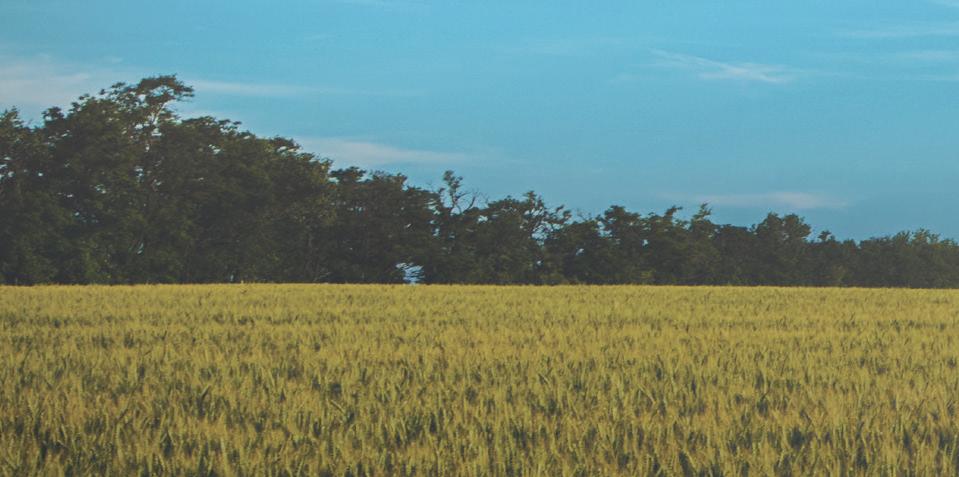




The Ohio Agriculture Conservation Initiative (OACI) is an unprecedented partnership between agriculture, conservation, environmental, and research communities to recognize farmers for their dedication to utilize established methods to improve water quality in Ohio and to increase the number of best management practices being implemented on farms.
The H2Ohio initiative was developed to ensure safe and clean water for all Ohioans. The plan invests in targeted solutions to help farmers implement best management practices on their farms. OACI will work with the H2Ohio program to ensure funds get to farmers who demonstrate a commitment to continuous improvement through the implementation of science-based practices.
By collaboratively learning and sharing information, Ohio’s water quality advocates stand as a united front dedicated to identifying solutions and helping farmers implement them.
OACI partners include a diverse group of organizations:






OACI was formed to accomplish two key goals:
» Assess farm practices in Ohio to better understand current on-farm conservation and nutrient management efforts.
» Create a new, voluntary certification program for farmers to promote continuous improvement and increase adoption of best management practices to improve water quality in the Western Lake Erie Basin.
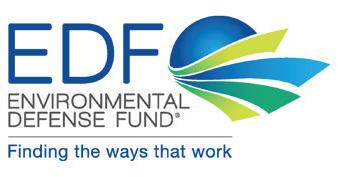

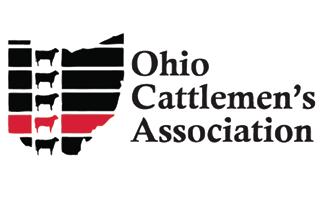


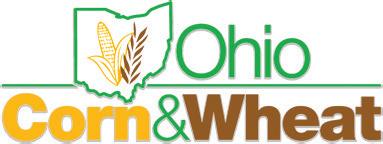


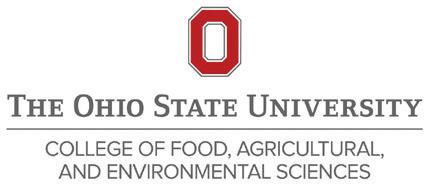

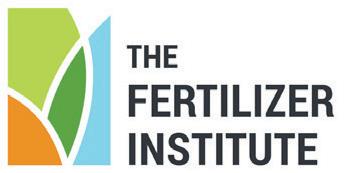














Enrollment is now live for the Ohio Agriculture Conservation Initiative (OACI) Farmer Certification Program, which will help farmers take conservation programs to the next level. Enrolling through the app at OhioACI.org is easy and only takes a few minutes to complete!
1.Visit www.OhioACI.org
2.Scroll down to Farmer Certification Program and click CREATE FARMER PROFILE.
3.Click REGISTER and enter a valid email address. Click REGISTER
4.Go to the email account you entered on the register page. You should have an email from OACI Admin. CLICK THE LINK to verify your account. This will send you back to the OACI app to fill out the information needed to create an account, including:
a.First and last name
b.Username (Tip: set your email address as your username for an easy way to remember it for logging in)
c.Create a password
5.Click REGISTER.
6.Once signed in, click on FARMER PROFILE on the left side of the screen. It will then prompt you to answer questions regarding general farm information, nutrient information, nutrient recommendations, and cost share.







01 - GENERAL INFORMATION:
•Name
•Phone Number
• Username
•Farm Name
• Address
•County – select from dropdown menu under ‘Add County’ – you can add as many as needed
•Watershed(s) – select from dropdown menu under ‘Add Watershed’ or click on the blue ‘Don’t know your watershed, click here’
02 - FARM INFORMATION:
•Total Acres Farmed (Owned/Controlled; Rented)
•Acres Per Crop Rotation - If needed, click the green button to add another crop
03 - NUTRIENT INFORMATION:
•Nutrient Sources (Owned/Controlled; Rented) –Breakdown of Fertilizer, Manure, Biosolids and Other Acres
04 - NUTRIENT RECOMMENDATIONS*:
•NMP Complete (Yes or No. If no, has it been started?)
•FACT (Fertilizer Applicator Certification Training License) Complete (Yes or No. If yes, include date completed.)
•Nutrient Application on Frozen/Snow Covered Ground (Yes, No or I Don’t Know)
•Sensitive Areas (areas more susceptible for nutrient loss) Located and Mapped (Yes or No)
•Manure Storage (Dropdown menus to select species, amount of storage and type of manure)
05 - COST SHARE:
•Dropdown Menu of What Programs You are Currently Interacting With (CREP, CSP, EQIP, Other, Working Lands Program – may add multiple forms of cost share)
*Note: Where there is a blue circle with an ‘i’ on it, you can click on it for more explanation.
7.Any information missing will be listed on the bottom left. Once all required fields are completed, click SAVE.
CONGRATULATIONS! You are now enrolled in the OACI Farmer Certification Program. Please sign the form given to you with your H2Ohio contract and return it to nicole@ofswcd.org. After signing this page, please write in your name and county for easier verification. Watch for more information soon on the OACI Farmer Certification Program.
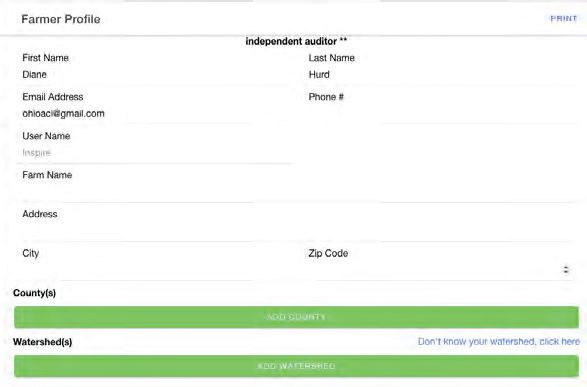






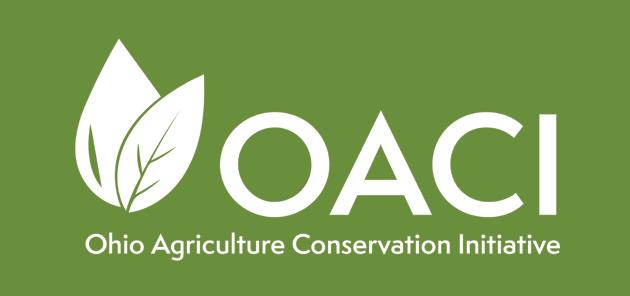


By Dusty Sonnenberg, CCA
One of the biggest barriers for farmers considering the transition to organic crop production is weed control. For Dave Shively of McClure, Ohio, weed control was one of the things that drew his interest to organic farming practices. “I have been raising crops organically for 16 years,” said Shively. “Before transitioning to organic grain production, I was getting tired of paying for conventional weed spraying and not seeing the results I wanted.
Shively says that if a farmer is going to be successful with organics, they must be committed to the system. “My wife first had an interest in edamame beans, so as we looked into those, I talked to some guys who were farming organically. That led to me try growing organic on a small scale to see if I could manage it,” said Shively. “We had a lot of ground in alfalfa and hay for several years that aided in the three-year organic certification transition. I asked a lot of questions to guys who were growing organically, and then I started with one field. The next year I transitioned another field. Organic production takes time and management. A farmer needs to be committed to the system.”
A good organic system involves protecting the soil with cover crops. It also involves using tillage to control weeds. “We do a lot of tillage early in the season,” said Shively. “I always want my ground to be covered, so I plant a cover crop mix in the fall, and then will chop it in the spring and work it in to help break down the residue and also help control

any weeds. The spring tillage will level out any ridges that remain from cultivating the previous crop.”
Weed control is one of the more time-consuming activities in organic production. In season tillage for weed control is a regular activity. “Just before we plant, and then again right after planting I will run a rotary hoe 2 to 3 times to lightly take out any small weeds that are emerging. It helps the stir the surface of the soil and get some of those weeds to emerge, and then get them out before they get too big,” said Shively. “We will plant the regular crop a little deeper than normal, and at a little higher seeding rate knowing that we may thin it during the cultivation passes. Once the crop emerges, it is important to have a cultivator with good spoons, and now a lot of guys are even going to the tine cultivators. Typically, most of the weed pressure comes in the rows. We can cultivate out the weeds between the rows, but
Dave Shively has been growing organic crops for 16 years – and weeds are always a concern.
in-row weeds are our biggest problem.”
Shively raises organic corn, soybeans, and wheat; along with some alfalfa and red clover. “This year I had a one of the nicest wheat crops I have raised organically,” said Shively. “With my production system, typically soybeans will not be harvested until later in October, so getting a good stand of wheat established by that time in the fall of the year can be a challenge. Last year because we had some prevent plant acres, I was able to address some weed issues, and get the wheat planted timely and a very nice stand established.”
This year Shively is raising an organic, food grade, seed stock bean for Albert Lea Seeds. “This field is soybeans back to soybeans. It is an Albert Lea Seed variety that was a
food grade bean in the conventional market, but they had foundation seed, and these will actually be considered organic seed for them for next year. They are a 3.1 maturity, and are supposed to be above 42% protein according to the literature,” said Shively. “They will be delivered to Hirzel Farms to be cleaned for Albert Lea and then used for seed next spring.”
“This was the first year I have grown beans back to beans. Normally it would have been an organic corn field, but the corn market has been so depressed that I decided to go back to soybeans,” said Shively. “My normal crop rotation is corn, beans, wheat, and hay. Occasionally I will also grow organic seed oats. Organic growers are typically very rotational with a small grain and a clover or cover crop included in the rotation. We grow our own nitrogen.”
When it comes to pest control, Shively has an organic philosophy. “Let the good bugs eat the bad ones,” said Shively. “I think at times the insecticide that is sprayed on crops kills all the good bugs that would normally eat and help control the bad
ones. I have been fortunate, and not had significant insect pressure that has caused a problem.”
Organic crop production involves being a good steward to the environment and to the neighbors. Weed control is always a concern. “A few years ago I had an organic wheat field with thistle patches that got really bad and were going to go to seed and spread if I did not do something. Unfortunately, they were so thick across the field that I went ahead and mowed the field down, wheat and all to control the thistles,” said Shively. “I obviously did not want to do that, but I also did not want the thistles to go to seed, or spread to the neighbors. This year I had a ragweed and velvet leaf problem in a field of beans. I needed to find a rescue treatment, because the regular cultivation I do did not control the weeds late in the season. I had heard about some guys who had a tool that used electricity to kill the weeds
The Weed Zapper uses an electric charge to kill weeds, but keeps crops intact.

and make the seed not be viable. I called around and got the name of Seth Stutzman from the Plain City area, who has The Weed Zapper. I contacted a couple other organic growers in the area, and together we rounded-up enough acres to justify him bringing his equipment up to run for us.”
The Weed Zapper’s overall concept is relatively simple. It can be used once the beans have canopied and the weeds begin to emerge above the canopy. The boom height is run a couple inches above the soybean canopy, and only comes in contact with the weeds, sending a charge through the weed to kill it, but leaving the crop unharmed. The Weed Zapper has two rolling coulters that ground the system. It completes the circuit when the power from the boom brushes across the top of the weed, and then flows through it into the soil and is grounded. The cell walls inside the weeds rupture when 15,000 volts of electricity flow through the plant, and it kills it down to the roots. The longer the boom is in contact with the weeds, or the electricity flows, the more effective it is a killing the weed. “It is not something that can get all the weeds, but works well as a rescue treatment for late season outbreaks,” said Shively. “After he went across the field, the weeds and seed pods all shriveled up and died. This tool is also gaining popularity with conventional soybeans in areas where they have outbreaks of herbicide resistant weeds.” u
This article originally appeared on Field Leader, the Ohio Soybean Council’s online resource to give farmers access to the latest soybean checkoff research and water quality information to enhance their operation. Find more articles like this one at OhioFieldLeader.com


As Americans, we’re spending more time in our homes than ever, and are more motivated to protect their comfort and value than ever before. Roof Maxx, www. RoofMaxx.com, the U.S.-based network of roof restoration experts, became the nation’s fastest growing roofing business in 2019 by delaying costly replacements of asphalt roofs with an all-natural, soy-based shingle rejuvenator spray application.
Today the company is taking its growth to a new arena: Roof Maxx has forged an alliance with Kevin Harrington, an original “Shark” from the hit TV show Shark Tank. Together, Roof Maxx and Harrington intend to make every homeowner in America aware of its eco-friendly and cost-effective alternative to rejuvenate instead of replace asphalt roofs.
“More than 80 percent of roofs are asphalt and increasingly, asphalt shingles are failing more quickly,” says Mike Feazel, Roof Maxx co-founder and CEO. “Worse still, the increasing desire for solar makes failing roofs an even greater challenge, as it is impractical or unfeasible to install solar panels on a roof with fewer than
five years remaining of reliable use.”
The home improvements industry accounted for $394 billion in 2018 and is expected to reach $680 billion by 2025. Even prior to the days of
an asphalt roof,” Harrington said. “It is an ideal solution and time for the marketing megaphone I can help them create. I am excited to participate in this tremendous company to help

#WorkFromHome and COVID-19, homeowners are increasingly conscious of protecting and building the value and comfort of one of their biggest investments: the family home.
Harrington is well aware of this motivation, as home improvement was his first focus and the theme of many of the “million-dollar products” he has launched and grown since pioneering the modern infomercial in 1984 and leading increasingly effective business acceleration programs in the threeand-a-half decades since.
“What Roof Maxx has accomplished is revolutionary, not only for homes but for every variety of building with

maximize the effectiveness of their next phase of growth.”
When used every 5 years, Roof Maxx extends the life of a roof by as many as 15 additional years. The average replacement cost of an asphalt roof is about $12,000, but a Roof Maxx treatment typically costs only 15%-20% of the price of replacement.
Roof Maxx’ impact on the environment is significant as well.
According to an Ohio State University study, approximately 7 percent of U.S. roofs are replaced every year. If even 1 percent of single-family homes (about 15 percent of yearly replacements) applied a SMEE (Soy Methyl Ester Emulsion) formula like Roof Maxx instead of replacing their roof, we would avoid 5.6 billion pounds of landfill waste and 1.1 million metric tons of CO2 equivalents in emissions.
In 2019, Roof Maxx received global recognition from the World Bio Markets as a Top 10 Most Dynamic and Inspiring Startups of 2019.
Additionally, Columbus Business
First selected Roof Maxx as a BizTech Awards honoree for Green Innovation and acknowledged Mike Feazel as a 2019 Executive of the Year. u


Amidst the pandemic, U.S. farmers are still connecting with their global customers near and far to increase demand for U.S. Soy. The U.S. Soybean Export Council (USSEC) and The Specialty Soya and Grains Alliance (SSGA) co-hosted 1,000 global customers and soybean industry representatives from 69 countries for the U.S. Soy Global Trade Exchange & Specialty Grains Conference (GTE), August 24-27. The conference’s digital capability allowed those who weren’t able to attend live to watch the sessions on-demand following the event. As its first ever virtual debut, the conference covered global innovations, world soy supply and demand and the high-quality advantages of U.S. Soy and specialty grains through live panel discussions, 360-degree farm tours, personalized one-on-one meetings and digital trade show, where the Ohio Soybean Council (OSC) had a booth to promote Ohio beans.

to expect from this annual conference.”
“Undeterred by vast changes and challenges this year, USSEC remains hard at work building and cultivating relationships with stakeholders around the world. The U.S. is a consistent trade partner with cutting-edge sustainability initiatives, defined quality advantages and it’s critical we continue to highlight our reliability to key and emerging global markets through digital events,” said Jim Sutter, USSEC CEO. “With this new virtual format, attendees had access to the quality content, interactive sessions and valuable experiences they’ve come
Livestreamed in several different languages, attendees heard from globally recognized experts, U.S. soybean farmers about the 2020 growing season, and key leaders from the U.S. Department of Agriculture (USDA) and the Office of the U.S. Trade Representative (USTR) on an array of topics, including — Your Sustainability Solution: U.S. Soy, Container Shipping Landscape: The New Reality and U.S. Soy Oil’s Premium Advantage Hits the Mark, among many others.
“We have been able to take advantage of what a crazy year 2020 has been to show our international partners that the U.S. continues to be a sustainable and reliable source of high-quality soybeans, even in the face of a global pandemic,” said Bob Suver, OSC demand committee chair and Clark County soybean farmer. “As we have
been forced to adapt to meeting with buyers virtually, it has allowed us to learn new ways to interact with international customers that we can use to continue to connect even after the pandemic ends.”
Sessions were held over four days and noteworthy speakers included:
Ted McKinney, Under Secretary of Agriculture for Trade and Foreign Agricultural Affairs, USDA
Ken Isley, Administrator of the Foreign Agricultural Service, USDA
Gregg Doud, Chief Agricultural Negotiator in the Office of the United States Trade Representative
Kevan Hueftle, Paralympic Track & Field athlete
RFD-T V’s Team of Market Day Report Anchors
Emily French, ConsiliAgra
Managing Director
Will Sawyer & Tanner Ehmke, C oBank Knowledge Exchange u
“ My soybean checkoff investment means that farmers are willing to invest in our future. It makes me feel like somebody’s out there putting their best foot forward for me. I can’t be two places at once. I can’t run a farm, raise a crop, reach out globally and prove to people that I grow a great product.”
-WADE MCAFEE, DELAWARE, OH

We know you can’t be everywhere at once. By investing in the soybean checkoff, farmers can concentrate on running their operations while the Ohio Soybean Council works to increase global demand, improve yields and create new opportunities for future generations.
Learn more at SoyOhio.org/HereWeGrow.